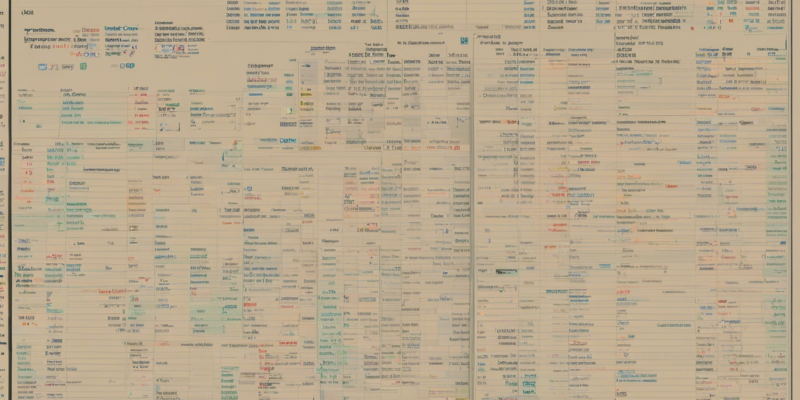The world of finance is vast and ever-evolving, with new technologies and innovations constantly reshaping the way we think about investments, trading, and wealth management. One key aspect of this landscape is ticker finology. The term “ticker” refers to a unique series of letters assigned to a security for identification purposes, which is used for tracking its price and trading activity in the market. In this comprehensive guide, we will delve deep into the world of ticker finology, exploring its significance, how it works, and its impact on investors and traders alike.
Understanding Ticker Symbols
Importance of Ticker Symbols
Ticker symbols serve as a shorthand way of uniquely identifying a particular security or stock on an exchange. They play a crucial role in facilitating efficient trading, enabling market participants to swiftly and accurately locate and transact securities of interest.
Structure of Ticker Symbols
Ticker symbols typically consist of a combination of letters, and in some cases, numbers. For example, the ticker symbol for Apple Inc. is AAPL, while that of Alphabet Inc. (Google) is GOOGL. Understanding the structure of ticker symbols can provide insights into the company they represent.
Types of Ticker Symbols
Common Stocks
Most individual stocks or equities are denoted by a simple ticker symbol that is easily recognizable to investors and traders.
Preferred Stocks
Preferred stocks, which have different characteristics from common stocks, often come with unique ticker symbols to distinguish them from regular equity.
Exchange-Traded Funds (ETFs)
ETFs, which are a type of investment fund traded on stock exchanges, have their own set of ticker symbols to differentiate them from individual stocks.
Options and Futures
Derivative securities such as options and futures also have specific ticker symbols that signify key details like expiration date and strike price.
Ticker Symbols and Market Capitalization
Small-Cap Stocks
Companies with relatively small market capitalization often have ticker symbols composed of fewer characters, reflecting their smaller size and scale.
Large-Cap Stocks
In contrast, large-cap stocks belonging to major corporations may feature longer ticker symbols that are easily recognizable due to their prominence in the market.
Ticker Symbols and Trend Analysis
Chart Patterns
By analyzing ticker symbols in conjunction with price charts, traders can identify patterns and trends that may offer valuable insights for their trading strategies.
Technical Indicators
Various technical indicators such as moving averages, relative strength index (RSI), and stochastic oscillators can be applied to ticker symbols to gauge market sentiment and potential price movements.
Ticker Symbols and Investment Strategies
Sector Analysis
Investors often use ticker symbols to categorize stocks by sector, enabling them to construct diversified portfolios and capitalize on industry-specific trends.
Stock Screening
Ticker symbols play a vital role in stock screening tools that allow investors to filter and identify securities based on specific criteria such as market cap, dividend yield, and P/E ratio.
Market Monitoring
By keeping a watchful eye on ticker symbols of key indices like the S&P 500 or Dow Jones Industrial Average, investors can stay informed about overall market performance and sentiment.
Ticker Symbols in Online Trading Platforms
Search Functionality
Most online trading platforms provide a search feature that enables users to quickly look up and access securities using their ticker symbols.
Watchlists
Traders can create customized watchlists comprising their preferred securities and their respective ticker symbols for easy tracking and monitoring.
Price Alerts
Setting up price alerts based on ticker symbols allows traders to receive notifications when a security reaches a certain price level, enabling timely decision-making.
Conclusion
In conclusion, ticker finology is a fundamental aspect of the financial markets that plays a pivotal role in identifying, tracking, and trading securities. By understanding how ticker symbols work, investors and traders can navigate the complexities of the market with greater ease and precision. Whether analyzing chart patterns, constructing diversified portfolios, or monitoring market trends, the significance of ticker symbols cannot be overstated in today’s dynamic financial landscape.
FAQs (Frequently Asked Questions)
Q: What is the difference between a ticker symbol and a stock’s name?
A: A ticker symbol is a unique series of letters assigned to a security for identification purposes, while a stock’s name is the actual name of the company issuing the security.
Q: How are ticker symbols assigned to companies?
A: Ticker symbols are typically assigned by stock exchanges, in consultation with the company issuing the security, to ensure uniqueness and clarity in identification.
Q: Can two companies have the same ticker symbol?
A: No, ticker symbols are unique to each security to avoid confusion and ensure accurate tracking and trading of securities.
Q: Do ticker symbols change over time?
A: Ticker symbols can change due to corporate actions such as mergers, acquisitions, or rebranding, necessitating a new symbol to reflect the updated identity of the security.
Q: Are there any restrictions on choosing ticker symbols?
A: Stock exchanges have guidelines governing the selection of ticker symbols to maintain consistency and prevent inappropriate or misleading symbols from being used.


Comments